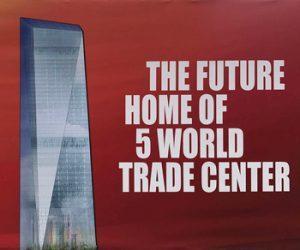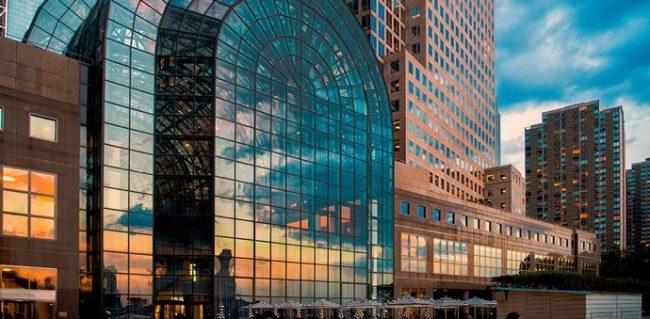After the devastation of the Sept. 11 attacks, it was years before the city and developers could break ground on the 16-acre site.
In the ensuing 18 years, the complex has come to include a memorial, museum, park, transportation hub, retail hub and office towers, most prominently 1 World Trade Center.
The development process continues today, helped in part by the continued success of the Downtown office market.

A rendering of 5 World Trade Center posted on a fence (Credit: CityRealty)
The skyscraper at 5 WTC has been on hold due to disputes between state agencies. Recent reports say that developers including Durst Organization, Tishman Speyer and a partnership between Silverstein Properties and Brookfield Properties are among those submitting bids for the project. Meanwhile, 2 WTC, in progress since 2008, has long been in limbo and may rise without an anchor tenant.
At the same time, the submarket that includes the WTC complex and Brookfield Place — the area south of City Hall and west of Broadway — has become a commercial leasing boomtown.
At the end of the second quarter of 2019, the WTC submarket had a 13.2 percent availability rate, the lowest since the recession, according to Franklin Wallach, a senior managing director in Colliers International’s New York research group. A year ago, that figure was 15.7 percent; five years ago, it was at more than 20 percent. Comparatively, availability within post-2000 inventory the wider Downtown market — which also includes the Financial District, the Seaport District, Battery Park and Tribeca — fell to 18.8 percent this year, down from 25 percent in 2018.
Since 2011, when Conde Nast made the decision to relocate to 1 WTC, Downtown Manhattan has leased more than 10 million square feet to large tenants moving from Midtown and Midtown South taking on spaces 50,000 square feet and up. The office tower at 1 WTC, which is co-owned by the Durst Organization and the Port Authority of New York and New Jersey, and Silverstein Properties’ 3 WTC, 4 WTC and 7 WTC, make up the bulk of Downtown’s post-2000 office inventory. And so far in 2019, Colliers has tracked more than 1 million square feet in the WTC complex alone.
Diageo, the British beverage company, leased an estimated 87,000 square feet at 3 WTC earlier this year, joining Hudson River Trading, which announced its plan to swap two floors at 4 WTC for four at its new HQ in January; law firm Kelley, Drye & Warren is moving into that same building, taking on 103,000 square feet, in fall 2020.
Recent deals fill nearly 10 million square feet of office space in Lower Manhattan, according to Wallach. So while the submarket has lost a little more than 3 million square feet of leases to other parts of the city, “net, Downtown is up by 6.3 million square feet.”
“Space is being leased in those buildings,” Wallach said. “Seven WTC is virtually 100 percent leased. 4 WTC: same thing. 1 World Trade Center: out of a more than 3 million-square-foot building, about four-fifths is leased.”

Brookfield Place at 230 Vesey Street (Credit: Brookfield Place)
The industries located Downtown have seen a sea change, too. In the 1980s and 1990s, Downtown was dominated by financial services, government, and legal. Today, the TAMI sector — tech, advertising, media, and information services — represented more than 50 percent of the 9.5 million square feet large tenant relocations to Downtown since 2011. The second highest industry shift, constituting 15 percent, has been in consumer goods and retail offices, including Gucci, Hugo Boss, Revlon, and the New Avon.
“The industry mix in Lower Manhattan has really become night and day,” says Wallach. “Anecdotally, from our view of the market: Each year, Downtown — not just the World Trade Center — is in a stronger and stronger position.”
Transportation has played a key role in the transformation: More than a dozen subway lines converge at Fulton Street terminal, which also connects to the Path station. The underground walkway connecting Oculus and Brookfield Place stretches from Williams Street to Winter Garden.
The Santiago Calatrava-designed Oculus, though, has endured criticism for its overwrought design and its nearly $4 billion price tag. It’s also seen its share of infrastructure issues, namely the rubber seal running along the center of the structure’s skylight is believed to have torn last year. The Port Authority used Flex Tape to seal the leak. Despite assurances that the retractable skylight would open in tribute to 9/11 victims Wednesday morning, that did not happen.
Wallach observes that housing development on the Eastside has supported the employee base for businesses that have set up shop Downtown, while at the same time Pier 11 is the “ultimate express stop” for waterway transportation, enabling New Jersey and Brooklyn residents to easily reach Downtown by ferry — a shift that has only taken root in the last two years.
Recent condo projects in the area include Magnum Real Estate Group’s 100 Barclay, Sharif El Gamal’s 45 Park Place, Silverstein Properties’ 30 Park Place and Alchemy Properties’ Woolworth Tower Residences.
“These are all things that have fed very well into supporting continued leasing at the WTC and Downtown in general,” he said.
